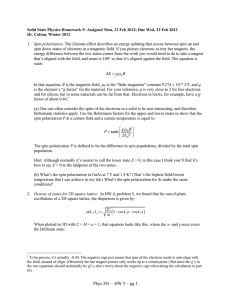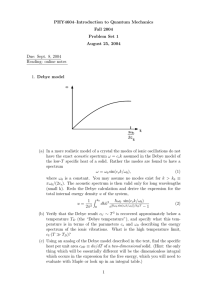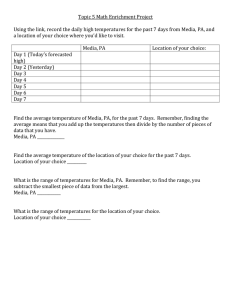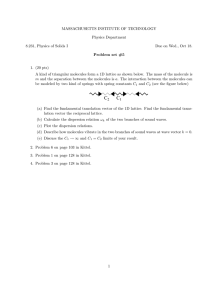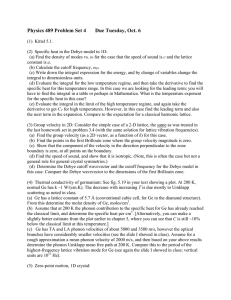Solid State Physics Homework 5: Assigned Fri, Feb 18; Due... Dr. Colton, Winter 2011 Density of states for 2D square lattice.
advertisement
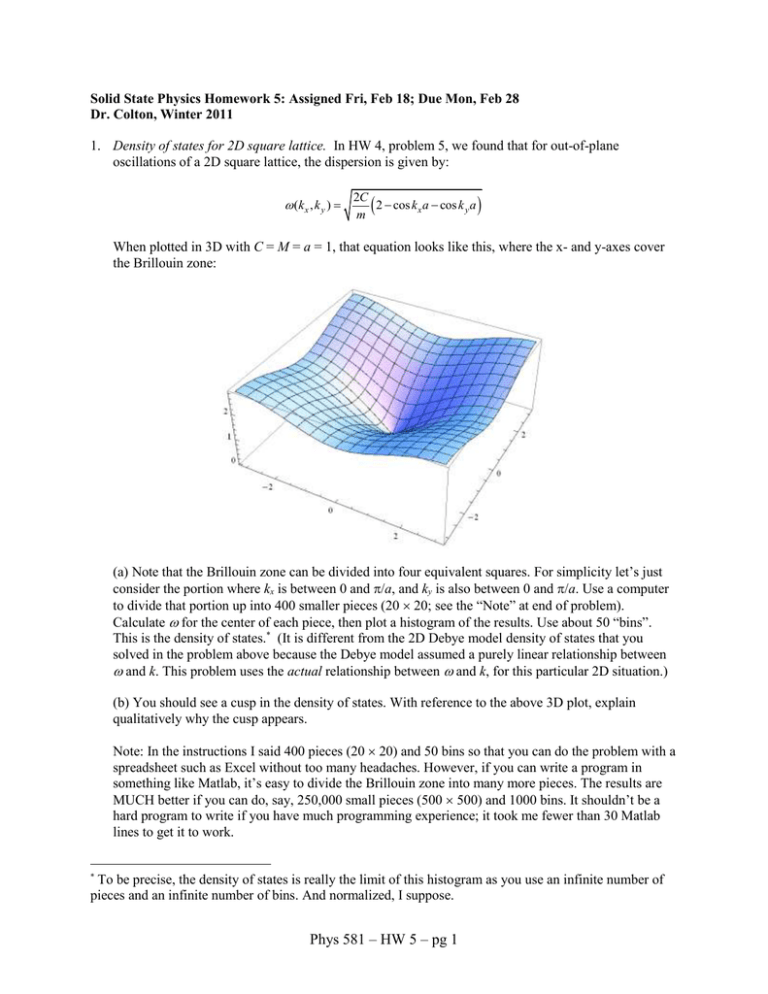
Solid State Physics Homework 5: Assigned Fri, Feb 18; Due Mon, Feb 28 Dr. Colton, Winter 2011 1. Density of states for 2D square lattice. In HW 4, problem 5, we found that for out-of-plane oscillations of a 2D square lattice, the dispersion is given by: (k x , k y ) 2C 2 cos k x a cos k y a m When plotted in 3D with C = M = a = 1, that equation looks like this, where the x- and y-axes cover the Brillouin zone: (a) Note that the Brillouin zone can be divided into four equivalent squares. For simplicity let’s just consider the portion where kx is between 0 and /a, and ky is also between 0 and /a. Use a computer to divide that portion up into 400 smaller pieces (20 20; see the “Note” at end of problem). Calculate for the center of each piece, then plot a histogram of the results. Use about 50 “bins”. This is the density of states.* (It is different from the 2D Debye model density of states that you solved in the problem above because the Debye model assumed a purely linear relationship between and k. This problem uses the actual relationship between and k, for this particular 2D situation.) (b) You should see a cusp in the density of states. With reference to the above 3D plot, explain qualitatively why the cusp appears. Note: In the instructions I said 400 pieces (20 20) and 50 bins so that you can do the problem with a spreadsheet such as Excel without too many headaches. However, if you can write a program in something like Matlab, it’s easy to divide the Brillouin zone into many more pieces. The results are MUCH better if you can do, say, 250,000 small pieces (500 500) and 1000 bins. It shouldn’t be a hard program to write if you have much programming experience; it took me fewer than 30 Matlab lines to get it to work. * To be precise, the density of states is really the limit of this histogram as you use an infinite number of pieces and an infinite number of bins. And normalized, I suppose. Phys 581 – HW 5 – pg 1 Side note: This problem is based on one that I found in an older edition of Kittel (6th edition). This line from that problem made me chuckle—the instructions started with, “If you have access to a microcomputer…” How times have changed! 2. Kittel 5.1. Singularity in density of states. Addition: in part (b), please do a quick sketch of your result, say from just below 0 to just above 0. Just a quick sketch on paper; no need to use Mathematica if you don’t want to. When you do so, you’ll see there’s another mistake here by Kittel: he says, “The density of modes is discontinuous.” What you should actually find is that the density of states is still continuous, but there’s a kink in it. 3. Debye model: 1D. Calculate the specific heat due to phonons in the Debye model for the 1D case. Follow the steps I used in class (and in the handout) for the 3D case. To review, those steps were: (a) Write down the density of states. (b) Calculate the cutoff frequency, D. (c) Write down the integral expression for the energy. Simplify as much as you can, and write the integral in terms of x (= /kT) instead of . (d) Do the integral for the low temperature regime. Take the derivative of U to get CV for this regime. Please leave this CV expression in terms of L. (e) Do the integral for the high temperature regime. Take the derivative of U to get CV for high temperatures. Please leave this CV expression in terms of N. 4. Debye model: 2D. Repeat the previous problem, for the 2D situation. (For part (d), leave in terms of A.) By the way, these 1D and 2D problems are not just mathematical constructs. Graphene, for example, acts in many respects as a 2D material. And there are other materials that act like 1D substances. For example, read through Kittel problem 5.4, Heat capacity of layer lattice. That situation has a 2D-like heat capacity at low temperatures, CV ~ T2, and a 1D-like heat capacity at even lower temperatures, CV ~ T. 5. Heat capacity of 1D linear chain. In Kittel problem 5.1 above, you solved for the density of states of the 1D linear chain situation—not a 1D Debye model, but rather the actual 1D monatomic balls & springs problem. Use that information to calculate the heat capacity for that chain (a) for low temperatures, and (b) for high temperatures. Note: I got it to work out by taking dU/dT before doing the low & high temperature approximations, and even before I substituted in for x. So, to make the grader’s life easier, please do that also. Word of caution: When you do the high temperature approximation, you’ll have a term like sqrt(xm2 – x2). Since x is small in this approximation, you’ll be tempted to say that that expression equals sqrt(xm2 – small) = sqrt(xm2) = xm. Don’t do that! While it’s true that x is small, xm is also small, so you can’t do things that way. Just leave that term in the integral and use Mathematica (or other favorite method) to integrate it. Final hint: You should end up with answers that share similarities with the Debye model: 1D problem above: at low temperatures CV should be linear with temperature, and at high temperatures CV should be a constant (the same constant as found for the previous problem). Phys 581 – HW 5 – pg 2
